
There’s one thing most businesses can agree on — there’s too much competition.
If you provide your audience the same experience they can get everywhere else, why would they convert into your customer?
The same goes for your landing pages.
When a potential customer arrives on your landing page, you only have one chance to earn their business. If your landing page fails to address the different needs of these potential customers, you’re likely to miss out on a sale.
That’s why it’s essential to implement personalization for your landing pages. Creating a great, personalized landing page isn’t difficult if you know the best strategies and have the right tools like Postalytics in your bucket.
Let’s first understand what it means to create “personalized” landing pages.
What We’ll Cover:
What Are Personalized Landing Pages?
A landing page is a website page with a specific purpose that the user enters to fulfill a specific need.
While landing pages may have different intentions, the main goal is to convert visitors into leads.
To increase the probability of conversions, you need to implement landing page optimization in terms of personalization. Personalized landing pages focus on how the same information can be displayed differently to attract and engage different target segments.
For example, if a visitor comes to your website from a different geographic location, you can change certain landing page elements to give them an easier experience.
You can even take information from your existing data gathered from other advertising campaigns to create dynamic landing pages instead of a single static landing page.
Why Should You Use Personalized Landing Pages?
When you send direct mail to your clients or prospects, you can bring these people online by printing personalized URLs on the direct mail that leads them to a specific landing page on your website.
There are a number of reasons why building personalized landing pages work.
- People expect personalized experiences from brands. According to a Salesforce report, 66% of customers expect brands to understand their needs and expectations. Creating personalized landing pages helps you fulfill this customer’s expectations.
- Achieve more conversions. When you tailor an experience to suit a customer’s requirements, you increase the probability of converting that customer.
- Form better connections. Personalized landing pages help you form a better bond with your prospects or clients, as they feel special when faced with an experience made just for them.
- Based on real data. Personalized landing pages are based on real data like demographics, shopping preferences, browser searches, or other actions. This makes them stronger than landing pages that are built backed by gut instincts.
- Provide the right offer at the right time. When data backs up your pages, you can provide the prospects with what they need at the right time.
How to Personalize Your Direct Mail Landing Pages?
Personalizing your direct mail landing pages can be challenging, but with these six steps, you can start your journey right away.
#1 Define your goals and objectives
Many businesses create landing pages based on a vague objective, such as improving conversions. But what kind of conversions are you targeting?
Without a specific goal, you won’t be able to iterate the landing page for more impact.
A personalized landing page is most effective when it acts as a campaign-specific page with a single focus denoted by the CTA (Call To Action). After opening your direct mail, it gets your visitors to perform a specific task.
Some examples of these goals could be:
- Getting email addresses
- Getting sign-ups for demos
- Creation of new accounts
- Generating more sales
- Getting more traffic to a particular page
- Getting to know your prospects/customers better
When setting these goals, ask yourself, “why.” For example, if you are trying to generate email addresses, be clear on what you need them for and how you’ll use them.
Outlining these goals allows you to measure the success of your personalized landing pages – and make effective tweaks – because it provides specific metrics and data to monitor.
#2 Identify your target audience
You can create the most beautiful landing page ever seen, but if it’s aimed at the wrong audience, it will fail to deliver results. Knowing your target audience is the next step to creating landing pages that convert.
One way to achieve this is to collect data on your existing customers from your CRM and sales and support team. You can also engage with your existing customers directly through outreach, asking them questions, or using onboarding surveys to gather behavioral and demographic insights that can help tailor your landing page’s messaging.

You can also use tools like Google Analytics to collect and analyze website visitors’ data by capturing important site interactions such as how frequently someone uses a feature, the number of pages they visit, where the click originated, past downloads, their company name based on the email address they entered, etc.
#3 Create your personas
The terms Target Market, Target Audience, and Target Personas may sound very similar, but there are nuances to each. Your Target Market is a broader group of individuals who might be interested in your product or service. Your Target Audience is a more specific group of individuals who are more likely to buy the product or service. Finally, your Target Personas are detailed profiles of the people you should try to connect with based on your Target Audience.
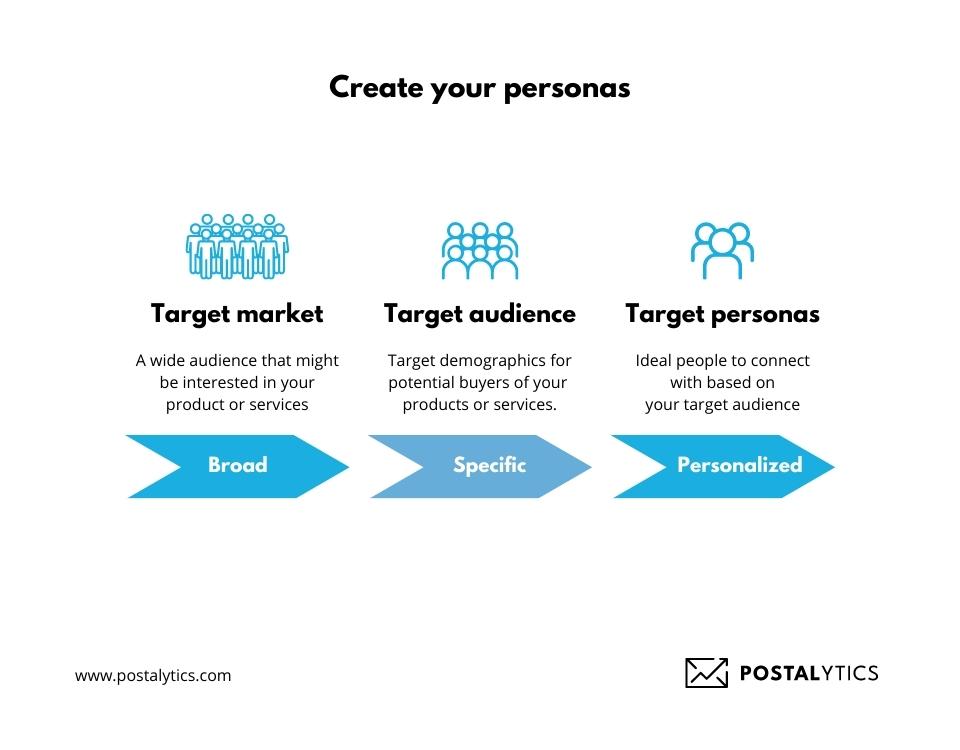
Once you have defined your overall target market, the next step is to divide this target market into different segments and create buyer personas for each.
To understand this better, let’s look at an example from a direct mailing perspective.
Suppose you have a project management tool. Your target market consists of businesses that handle projects. When you narrow it down, your target audience is construction companies, IT companies, marketing agencies, etc.
Your target personas are the key people in these companies. For example, if you have created a direct mail campaign for real estate project managers, this project manager is your buyer persona for construction companies.
These buyer personas are a semi-fictional representation of your company’s ideal customer. It paints the picture of who your customer is, what they do, their motivation and behavior, what their goals are, etc.
Here are some areas you can explore to define these personas:
- Demographics: Ask questions about age, gender, education and income levels
- Behaviors: Ask questions about how they use certain products, their habits or how they spend their time
- Challenges: Ask questions to gain insights into pain points
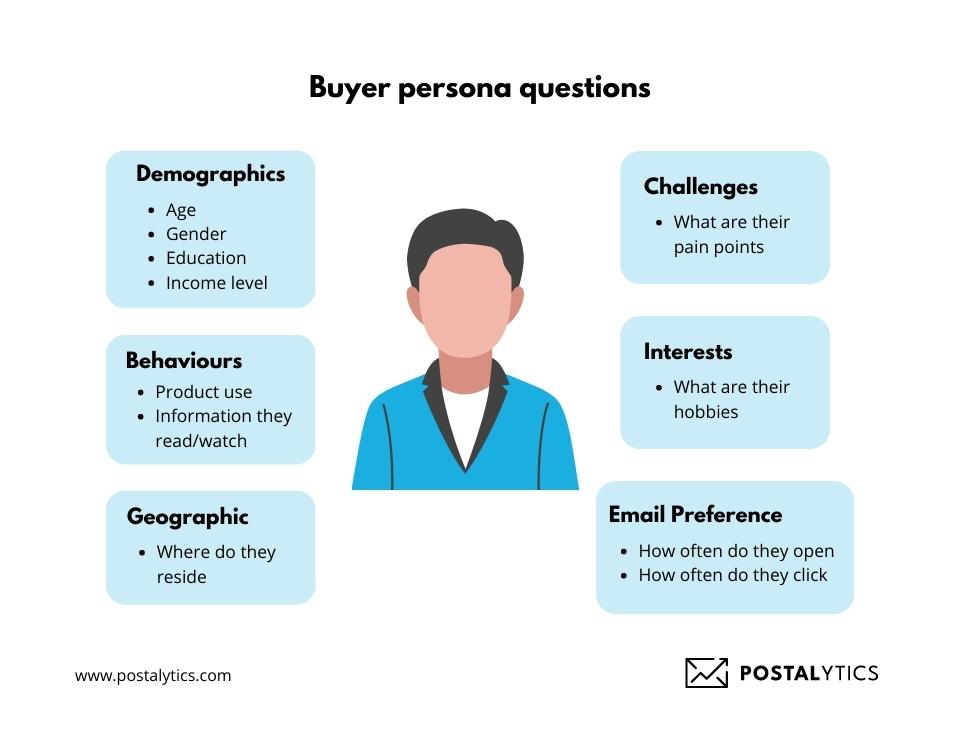
#4 Craft a personalization strategy
A good personalization strategy includes many things, like addressing individuals by name, including personalized offers, having information that meets the target segment’s needs, personalized CTAs, and ease of use.
Here are three strategies you can implement right away for your direct mail landing pages:
- Personalize greetings and communications
With Postalytics, you can create personalized URLs for your customers. This means you can provide a unique web address by the customer’s name, like the one given below for someone named Jen Johnson.

Every recipient will get a unique URL printed on their direct mail. This makes the recipient feel you have created a special webpage just for them.
Here’s how HubSpot personalizes its landing pages for its HubSpot partners.
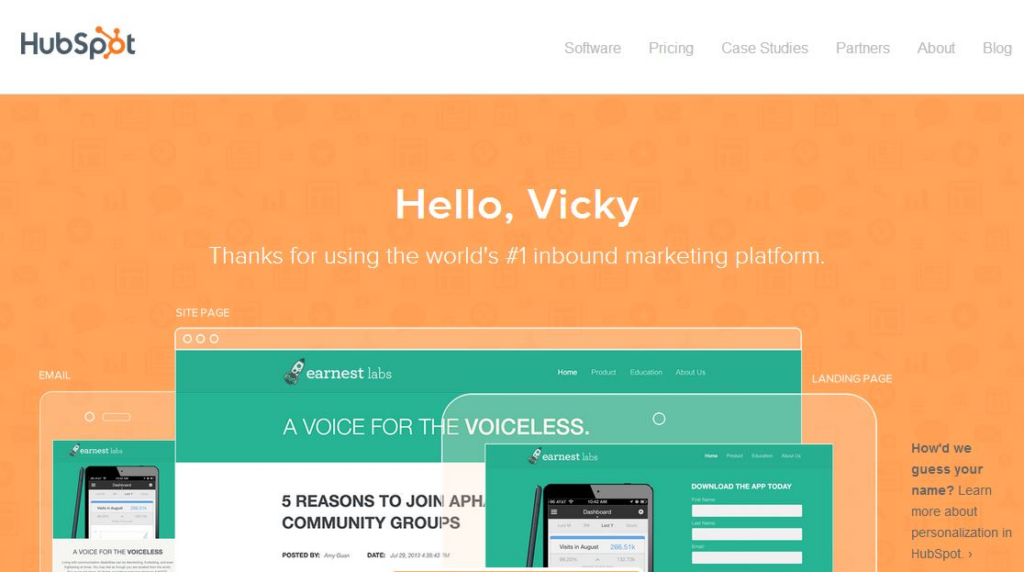
- Personalize offers and CTAs
Depending on your customer’s buying stage, you can show them relevant content based on their past actions to help them make a decision. You can even personalize offers on your landing pages based on their usage and the value they bring to your business.
For example, when ShipBob used varying CTAs and personalized offers on their blog, they saw a 123% increase in content downloads and a 53% increase in leads.
- Carry your personalization through
When a person goes to the personalized URL given on the direct mail, they will come across a personalized landing page. But it’s important to carry this personalization to the next step.
For example, once they click on the CTA, you can take them to a form that pre-fills data based on the information you have gathered on the existing customer.
#5 Test and experiment
Once your personalized landing page is live on the website, it’s time to test it. Here are some useful pointers you can keep in mind:
- If you feel you haven’t personalized your landing page enough because you don’t have information, you can host a quick survey on the landing page or product page. You can understand why a visitor is on your site and use that information to customize their experience throughout the site.
- Use location data to make your page more relevant. For example, if it’s the pricing page and the visitor is from London, the price should be displayed in pounds.
- Use a person’s history on your website to recommend related products or services. You can even use their purchase history. For example, if they purchased a vacuum cleaner from you, you can show them ebooks for cleaning.
You may even need to experiment with your landing pages multiple times before you get it right.
#6 Launch your pages with Postalytics
With Postalytics, you can develop easy, flexible landing page personalization elements to boost your campaign’s ROI.

These personalization tools work with the tracking code given on the direct mail and the data loaded into Postalytics contact lists to display unique content for each visitor.
Some of the personalization options you can select are:
- Greeting the visitor by their name
- Suggesting purchase items or donation amounts
- Pre-filling all or parts of a landing page form
- Varying CTAs for customers and prospects
- Varying imagery for different audience segments
- Varying offers for different personas
To know more about implementing all this for your direct mail landing pages, here’s our short guide with detailed steps.
What to Base Your Personalization On?
Adding the visitor’s name to the content is not the only strategy to make personalization initiatives effective. Other worthy inclusions are,
Location
You can personalize different landing page elements based on your visitor’s location. Here are some examples:
- Include location-specific keywords in your landing page title or subheadings. For example, “Best Social Media Agency in California.” Ensure that these keywords match the intent of your landing page and don’t feel like keyword stuffing.
- If you’re promoting an event via direct mail combined with landing page marketing, you can put the location and map details on the landing page.
- If it’s the pricing page, let the prices be denoted in location-specific currency – for example, INR for India, USD for California, etc.
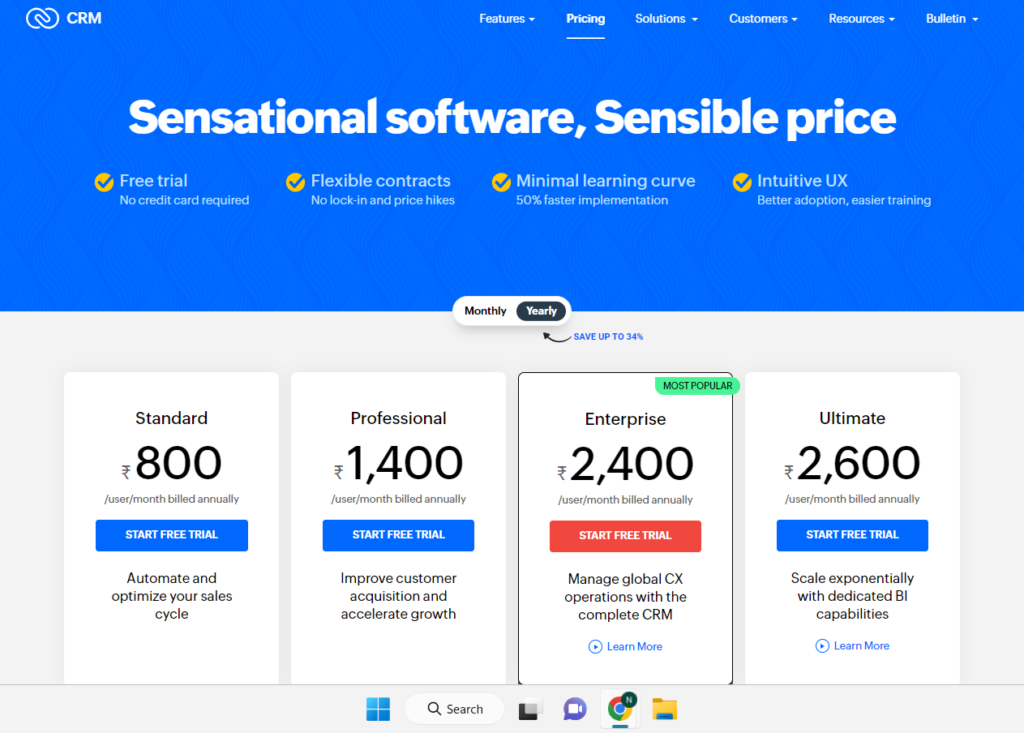
- You can direct your visitors to the nearest outlet or company branch based on their location.
- Show social proof on the landing page based on the visitor’s location. For example, if you have restaurants in different locations, show your viewers the reviews of the restaurant’s location nearest to them.
Page Content
Depending on what on-site interactions data you can fetch from tools like Google Analytics, you can personalize your landing page content.
For example, you can track visitors’ time on different web pages. Based on that insight, you can find the type of content that appeals the most to them. Then, you can put similar content on your landing pages to increase engagement.
Your CTAs can also be tailored to suit your target audience’s requirements. For example, the CTA for a design agency should be different from the CTA for a software development company.
The better you can create tailored page content, the better you can convert your website visitors.
Previous actions on your site
Say a visitor has already purchased a product from your site. You can use this information to recommend products based on their earlier purchase.
One SaaS company that executes this well is Netflix. It recommends the customers TV shows and movies based on their viewing history.
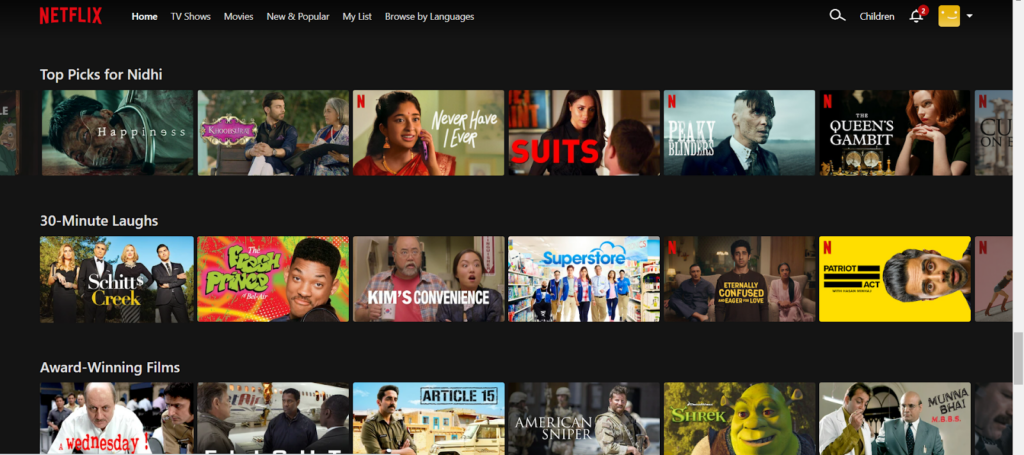
A great starting point would be to display a short “Welcome Back [name]” to engage your customer.
You can also tailor your offers based on the visitor’s previous actions. For example, if they bought something because of a previous offer, you can use this to your advantage and show them products that have similar offers.
What Happens When You Don’t Personalize Landing Pages?
Have you ever clicked on a link for Product A that took you to another page for Product B because the first one was sold out? Or did you click on a link to download an ebook, and you were faced with a form that asked you for all relevant details and didn’t even customize the experience based on those details?
Did you feel a little bit cheated? That’s what can happen when you don’t personalize your landing pages, especially when you have information on your customers.
Every day, your potential customers are exposed to 1000s of products, brands and services vying for their attention, and they will only engage with a small percentage of them.
Without personalized landing pages, you will fail to grab this selective attention.
Customers increasingly want experiences that don’t feel spammy or generic. Personalization helps you hit the right chords and form a better connection with your customers or prospects.
Final Thoughts
Personalized marketing is here to stay. By stepping up your game with personalized landing pages, you can deliver a better customer experience and move ahead of your competitors.
Whatever type of personalization you choose, be sure to test and experiment on many elements to find the best strategies for you.
If you need an easier way to start with personalized direct mail landing pages, sign up for Postalytics and create one in a few simple steps today.
About the Author

Dennis Kelly
Dennis Kelly is CEO and co-founder of Postalytics. Dennis joined Boingnet, the predecessor to Postalytics, in 2013. Boingnet was focused on providing print and direct mail marketing service providers the ability to add digital marketing channels to their direct mail campaigns. Postalytics is Dennis’ 6th startup. He has been involved in starting and growing early-stage technology ventures for over 30 years and has held senior management roles at a diverse set of large technology firms including Computer Associates, Palm Inc. and Achieve Healthcare Information Systems.
